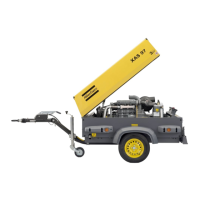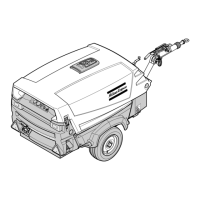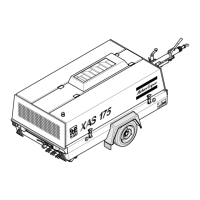1310 3011 08 15
2.7.2 Description
Operation of the electric circuit In detail
Start button S1 position 1:
Line 2 on 12V contact K3 closed (13-11), lamp H2 is
on. K4 excites contact K4 (18-15). Thermocontact
element S5 normally closed, K1 excites contact K1
(1-4).
Use of lamp test:
Start button S1 position 1 press lamp test S4, across
K3 and line 9 lamp H1 and relay K2 are excited.
After releasing lamp test button S4, lamp H1 remains
on, S4 taken over by contact K2.
Start button S1 position 2:
Line 3 on 12V (override function) hourmeter P1 and
fuel solenoid Y1 excited. Thermocontact engine S2
normally closed, oil pressure contact S3 open.
Start button S1 position 3:
Start relay K0 is excited and starter motor is running,
engine builds up oil pressure and oil pressure contact
S3 closes. K3 excited and contact K3 changes over to
(13-10). Relay K2 no longer excited, contact K2
opens, lamp H1 goes out. Alternator also commences
supplying voltage and K4 is no longer excited and
contact K4 changes over to (18-16). Lamp H2 goes
out, one can release start button S1 and it returns to
position 1. Exciting the safety devices occurs no
longer across line 3 but across line 2 to line 4 and this
way to line 3.
Explanation of shutdowns:
Oil pressure contact S3 opens, K3 no longer excited. K3
changes over (13-11), engine cuts out because fuel solenoid
Y1 no longer excited and lamp H2 goes on simultaneously.
Thermocontact S2 opens, K3 no longer excited. K3 changes
over (13-11), engine cuts out because fuel solenoid Y1 no
longer excited and lamp H2 goes on simultaneously.
Thermocontact S5 opens, K1 no longer excited. Contact K1
changes over (4-2). K3 no longer excited. K3 changes over
(13-11), engine cuts out because fuel solenoid Y1 no longer
excited and lamp H2 and H1 go on simultaneously. Take-
over relay K2 is excited simultaneously with H1 and contact
K2 closes (8-6).
Thermocontact S5 cools off and closes, K1 excited again and
contact K1 changes over (4-1). However, lamp H1 remains
on across line 9 and contact K2 (6-8).
A fault in the alternator part causes terminal D+ to go to 0V
and K4 to be excited. Contact K4 changes over to (18-15),
engine cuts Out because fuel solenoid Y1 no longer excited
and lamp H2 goes on simultaneously.

